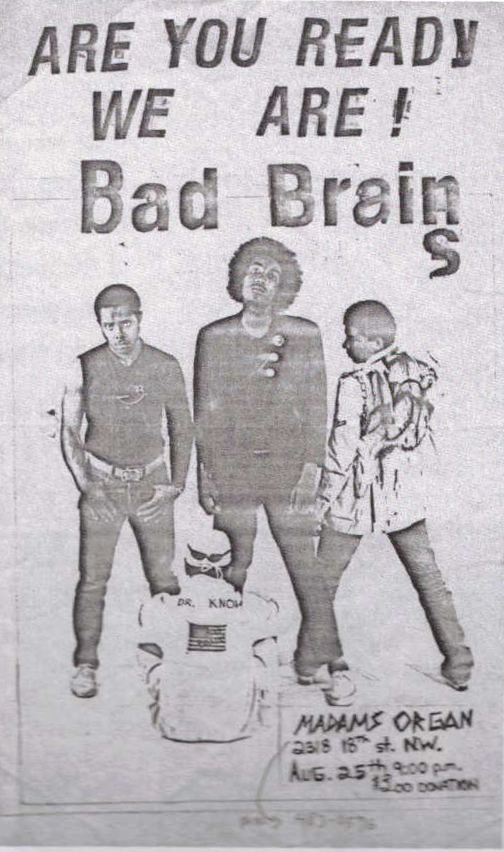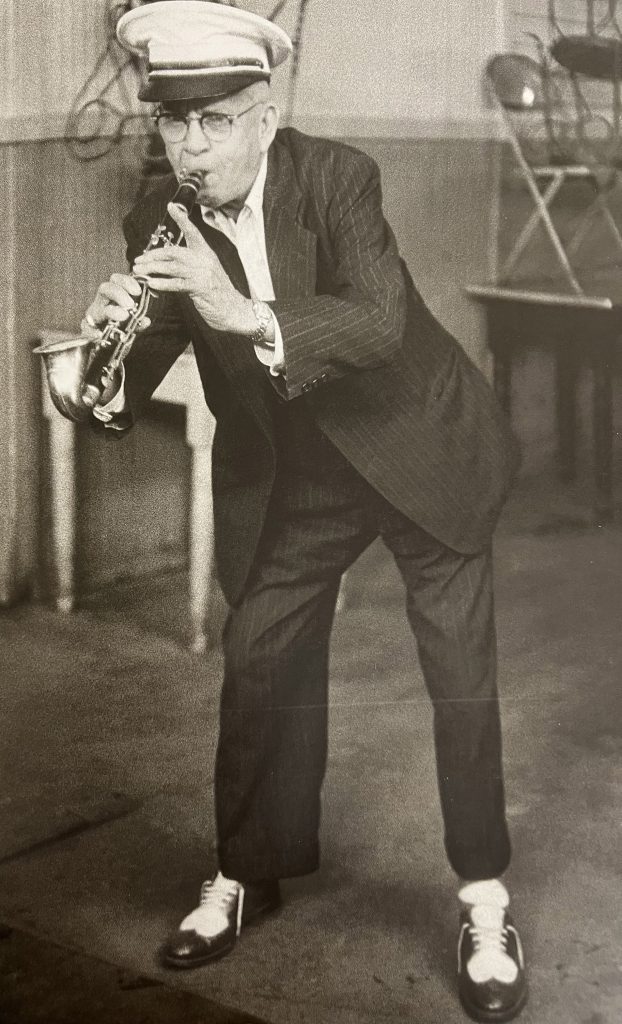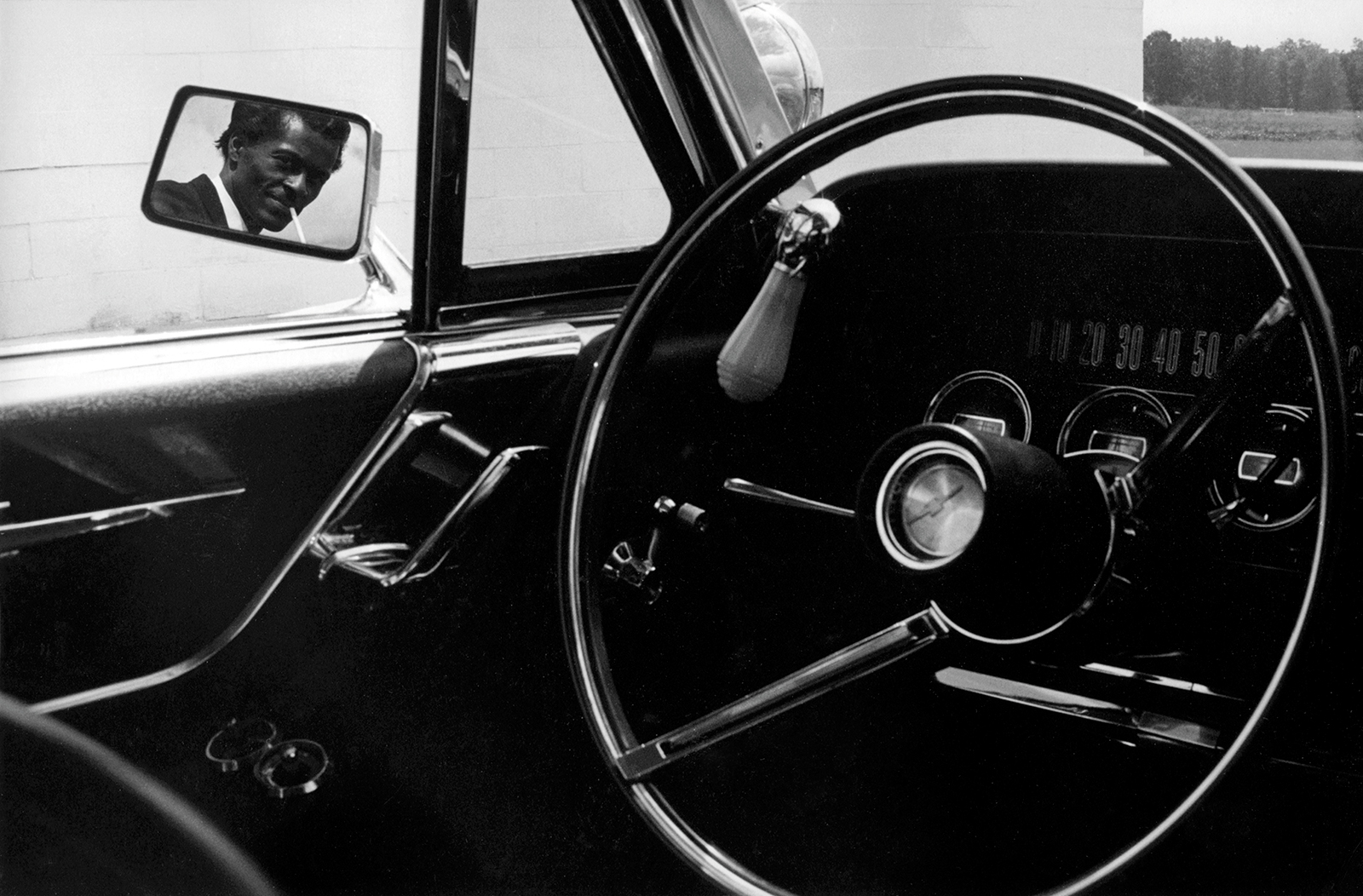Category: Music
Tom Petty – Green Onions
Alice Cooper – Clones

This is Alice Cooper at Max’s Kansas City in 1973. This image came from “Max’s Kansas City: Art, Glamor, Rock and Roll” as did the previous one of Johnny Thunders and David Johansen.
Johnny Thunders – Cool Operator
Here goes Johnny Thunders with another cool operator…
David Johansen & Johnny Thunders – Max’s Kansas City / 1973
From “Max’s Kansas City: Art, Glamor, Rock and Roll“
Photo by: Bob Gruen

Bad Brains – At the Movies

Alphonse Picou – High Society

Cherry Wainer & Don Storer – Peter Gun
Ike and Tina Turner – Evil Man
Black Sabbath – Evil Woman
An Anthropologist of Filth
By Ian Penman From Harper’s

On Chuck Berry
Discussed in this essay:
Chuck Berry: An American Life, by RJ Smith. Hachette. 432 pages. $32.
By the time Chuck Berry had his breakout hit “Maybellene” in the summer of 1955, he was already nearly thirty years old, with significant experience: he had spent three years of his adolescence in a reformatory for armed robbery; been a boxer and a janitor; worked in an automobile factory and an ammunition plant; trained as a hair stylist and a beautician; been married for nearly seven years; and been industrious and canny enough to purchase a pretty three-room house for himself and his wife, Themetta, known as Toddy. He had one existence chalked up, and was headed out toward several more.
“Maybellene” is classic Chuck Berry: a boy driving a Ford V-8 is chasing a girl in a Cadillac DeVille, the two cars potent symbols for sexual jockeying and pursuit. A rhythm of negotiated feint, never crossing into anything too obvious or vulgar—bumper-to-bumper, side to side, until finally the man-machine gives up the ghost. “The Ford got hot and wouldn’t do no more.” But then he suddenly revives and catches Maybellene “at the top of the hill.” Crest, cusp, plateau. The world spread out before him, waiting to be embraced.
This revving, frisky 45 is a logbook containing the codes and call signs of the postwar dispensation. As RJ Smith puts it in his new biography, Chuck Berry: An American Life, the artist “invented images and they came alive in the world.” He would be adored and imitated by the Beach Boys, the Beatles, the Rolling Stones, and countless others. The world of teenage desire had found its poet laureate—and he was not young or white or innocent.
Smith opens his story near the end of Berry’s life and finds that cars still have a central place in it. In 2011, Berry gets a phone call from the National Museum of African American History and Culture, which wants to exhibit his signature tan-colored Gibson ES-350T. Berry tells them that, yes, they can have the guitar (named Maybellene, as it happens), but on one condition: they must also take his 1973 red Cadillac Eldorado convertible. As if there were an equivalence between these two objects. Guitar and car joined in rhyme and joined at the hip.
Back in the day, before anyone worried about fossil fuels, the glory of a brand-new Cadillac was self-evident. It stood for money and leisure, pleasure and escape. It was something that could take you out of your small-town life, but also something you might want to drive back into that same small town later to signify and show out a little. To Berry, cars were a “sign of his mastery of success,” Smith writes, an “expression of mobility, the idea that anybody could go anywhere they wanted.” The truth is no longer sought in the ragged howls of the blues or the verses of the Bible, but in a tank of gas and a rearview mirror. Berry’s songs echo black postwar struggle for freedom of movement, with all the struggle taken out: sunny, upbeat, their rhythms loping, casual, top-down.
But the mid-Fifties world of “Maybellene” was still a segregated one; this seven-inch celebration of gas-pedal verve and unbridled liberty was released the very same year as Rosa Parks’s historic protest. Someone like Berry might have found that the prevailing dream of automobility came with previously undisclosed clauses in fine print. A self-possessed, sharply dressed black man with a pretty white girl in his passenger seat couldn’t ever count on being able to drive no particular place for no especial reason without being harassed. A flashy Cadillac was something that might also get you into big trouble. In December 1959, following allegations that Berry drove a fourteen-year-old waitress across state lines for the purpose of having sex with her, he was arrested under the much-disputed Mann Act. He claimed she was a hatcheck girl at his club. What’s not so well known is that the police had also found him with a seventeen-year-old girl in his car the previous year, and that he was let off with a fine (for missing license plates) and a relatively friendly warning.
Why didn’t he heed that warning? Was it a deliberate choice, a pointed provocation, a perverse compulsion, the assertion of a kind of doomed but sturdy personal ethic? There were times when Berry seemed almost to be daring authority to notice him. There is a definite sense of testing limits, courting retribution, pushing convention. It’s as if there are two Chuck Berrys: the jovial, jaunty character in his songs . . . and the real Charles Berry, jagged storm clouds massing above his head. The former sees an endless highway while the latter is prepared to haggle over a handful of change. One sees the possibility of a life outside conventions; the other spies a trap, and walks on in. The traps most often seemed to involve sex, moreover a fixation on sex that already involved pushing certain boundaries he would one day completely ignore. In 1989, it was discovered that he had installed hidden cameras in the women’s restroom of a restaurant he owned in his home fiefdom of Wentzville, Missouri. (Aside from all the other issues, the cameras routinely recorded footage of underage girls.) It’s the sort of scandal most public figures would never recover from, but Berry was helped by an egregiously mishandled investigation by local authorities, who, bafflingly, also tried, with barely any evidence, to paint him as a cocaine kingpin. (Berry did eventually settle multiple lawsuits brought by customers and restaurant staff.) Separately, and presumably consensually, it emerged that Berry had a massive collection of sex tapes, featuring himself and various women; seamy clips soon began to circulate, featuring Berry urinating on a sexual partner and being defecated on in turn.
Here are both the feathers and the talons of Berry. The inside of things and the outside. The toilet stall and the open horizon. His songs idealize the glinting surfaces of a new consumer society; his private pursuits involve sheer waste, base material, excess expenditure. The hidden-camera scandal is the ultimate example of divided or doubled Berry. He is both the impish spirit of rock and roll and its undisclosed agon. Here is the kind of small-town diner he might once have hymned in his golden-era songs, hijacked and stained by his own darkly private desires. Smith somehow manages to negotiate these oily, turbid waters with amazing grace, sure-footedness, and acuity. He is not forgiving of Berry’s crimes, but neither is he a self-righteous prig or martinet. Over the course of his excellent book, it becomes clear that Berry is an ideal case study for a moment relentlessly preoccupied with the chasm between the artist and the art.
Berry never claimed that he invented rock and roll, and was always quite happy to point out where he’d gotten his inspiration: from the great hinterland and invisible college of rhythm and blues. He happily fessed up to his influences, such as Louis Jordan and T-Bone Walker. There was a lot of guilt-free recycling involved—transplanting a riff or a lick, a line or a trope, into fresh new settings. (Jordan’s guitarist Carl Hogan was the source for the famous opening guitar riff of “Johnny B. Goode.”) Even the execrable (but insanely popular) late hit “My Ding-A-Ling” was a virtual xerox of a roiling 1952 R & B side by the marvelous Dave Bartholomew. He tinkered, customized, and retooled songs as if giving an old car a new coat of paint, adding horsepower, then taking them back out on the open road again.
What he did do, indisputably, was visualize a whole new postwar landscape, and provide a soundtrack for its leisure time: a hybrid somewhere between white pop and black R & B. Smith has a lovely phrase for this: “Scraps and rags and things given away for free were pulled together and made into a brand new flag.” Rhythm and blues had always referenced highways and trains (even that dark Faust of the Delta blues, Robert Johnson, name-checks Greyhound buses and Terraplane cars), but Berry was the first person to give it a pop art twist. “Up to the corner and ’round the bend / Right to the juke joint, you go in / Drop the coin right into the slot / You gotta hear something that’s really hot.” All the fetishes of the emerging teenage culture of ready consumption appear in the mind’s eye: car radios, bright milkshakes, sizzling burgers, blaring jukeboxes. Dating and driving and disposable income. There is far more clamor about travel and consumer goods in Berry’s music than there is about sex and/or love. Also notable: the number of songs that reference marriage. (If he were a book, he’d, improbably, be Georges Perec’s Things: A Story of the Sixties.) He doesn’t really write what you would call love songs—beautiful souls, pining hearts—rather, his songs are about things pursued, purchased, possessed. Various makes of cars. A “hi-fi phono.” High-heeled shoes. Skyscrapers. A TWA flight. “A model on the cover of a magazine.” Berry understood that technology would change everything, would shape the very nature of desire. “She could not leave her number, but I know who placed the call / ’Cause my uncle took the message and he wrote it on the wall.” Sharp and punchy and streamlined, his songs are like episodes of a TV series that had yet to be made by anyone.
From an early age, Berry loved to tinker: junior handyman, hipster bricoleur. “Taking things apart explained the way the world worked far better than a sermon,” Smith writes. Berry comes to see everything, including learning the guitar, as a matter of mathematics. Radios, guitars; he wants to see the nuts and bolts behind the magical sound. Central to his development were what he called the “magic boxes,” the family piano and the Victrola record player. There was nothing he liked to do more than take something apart and put it back together again—which is just what he did with his music. He took the reigning spirit of R & B—raucous, gritty, nasty, alternately melancholy and murderous—and toned down its saturnine aspects while buffing up and emphasizing its Saturday-night shine.
If his scientific bent was one thing that marked him out, the other crucial difference between Berry and his musical contemporaries is that he wrote his own songs. Most performers at the time relied for their material on managers, publishing companies, pals of pals, or pals of heavy guys in fedoras. Berry wanted to rely on no one but himself. Even if you’re not a big Chuck Berry fan, there’s no arguing with his back catalogue. To list just the best-known songs from his impeccable run between 1955 and 1964 is to survey an unparalleled achievement: “Maybellene,” “Roll Over Beethoven,” “Brown Eyed Handsome Man,” “School Day,” “Rock And Roll Music,” “Sweet Little Sixteen,” “Johnny B. Goode,” “Carol,” “Sweet Little Rock and Roller,” “Back in the U.S.A.,” “Memphis, Tennessee,” “Let It Rock,” “No Particular Place to Go,” “You Never Can Tell,” “Promised Land.”
Where did they come from, these songs? Robbie Robertson once asked Berry exactly this question, and Berry replied that there was absolutely no mystery: “It came from poetry. Poetry portrays a scene or a story and that’s where my lyrics would originate from.” Poetry was regularly recited at home, especially work by the black vernacular poet Paul Laurence Dunbar. This, Smith writes, gave Berry a sense of “what voices could achieve.” Both Miles Davis and Chester Himes—who, like Berry, grew up in St. Louis—recalled Dunbar as a huge childhood presence; Davis compared his “Negro Southern” voice to Lead Belly and Bessie Smith. Dunbar, Smith writes, was a “salesman selling his art, using the way people spoke”; he had the ability to talk to black and white audiences with an artfully folksy persona that was both “real and an invention.” All of this seems uncannily to predict crucial elements of Berry’s own act. But did it go further with Berry? There was one lesson from Dunbar that may have been key in shaping not just Berry’s lyrical gift but the man himself: “To speak one way with an audience did not mean that you were part of that audience.” The more you think about this simple sentence the more dizzying it seems to become. And there were times, late in life, when Berry looked like an audience of one—watching a DIY show whose value and purpose only he understood.
Berry also learned to be a great listener, thanks to the crazy-paving syllabus of the regional radio stations of that era.
He absorbed Ozark Mountain hayrides and hillbilly boogie . . . Cuban boleros, street-corner sweet talk, Mexican songs, Frank Sinatra ballads, and Frankie Laine melodramas . . . and put them together with the blues.
Over the radio, nobody’s skin tone was visible. The words are jingle-catchy, the music like tail fins turned into twelve-bar riffs. Here’s a salesman who has complete confidence in what he’s selling, because he made it himself and he knows that you’ve never had anything like it before. It’s the new thing! It’s the real deal!
Elvis and Little Richard and Jerry Lee sang as if they had something trapped inside of them that was so combustible it could only escape as a staggered hiss of stutters, moans, and squeals. When Berry sings, he enunciates crisply, as if he is still reciting poetry in his mother’s parlor. He never smears or elides his words, everything is clear and precise, milk teeth in the mouth of a cartoon character, pebbles in a stream. As an exercise, try reading out the lyrics of “Promised Land” yourself—even slowly, never mind at Berry’s kind of clip. The song communicates a feeling of travel as a breathless rush—and yet every name vibrates, every word rings like a bell. He’s a vaudeville comic who makes sure the whole audience, right to the back of the hall, registers every last hint, wink, and syllable.
Watch TV clips of Berry from his pomp (my favorite is a black-and-white one from Belgian TV, circa 1965, in which a sharp-suited Berry seems to be playing with a full-on jazz combo), and you realize that he was more of a natural all-round entertainer than most of his contemporaries. He managed to transfer the spirit of the traveling tent show into the compressed television age. He had an innate sense of what was required—something cool in both the jazz and the McLuhanite sense. He acts out his songs, using his exceptionally mobile face and beanpole body and cheese straw limbs. There is something almost unreal about him, like a zoot-suited roué out of a Tex Avery production. The country cousin and the city slicker in one and the same body. A walking contradiction.
What there was in Berry of a sunny disposition may have been shaped by his relatively safe and happy childhood. He was born Charles Edward Anderson Berry on October 18, 1926, at (note the name) 2520 Goode Avenue, and grew up in a black, middle-class neighborhood of St. Louis—a “place of self-sufficiency and independence.” Smith offers a nice cameo that seems quite telling: Berry’s father had purchased a truck to sell vegetables in their neighborhood, and a ten-year-old Charles would stick his head out the window, calling to potential customers in the rhythm of the motion of the truck. This is a life shaped for the bounce and prowl of R & B, not the gnawing stasis of the blues.
There was a paradox in the way the blues was framed by its early white enthusiasts: in order to be considered “authentic,” bluesmen had to remain bowed down, angry, bereft, defeated by the miseries of black life under American capitalism. Its practitioners, however, saw playing music precisely as a way out of that cul-de-sac. They wanted all the available spoils: shiny weekend suits, not tattered dungarees. Berry’s “poor boy” is no longer cooling his heels down on the farm, he’s being served food and drinks by an air hostess. There was no blues or church in Berry. His music may have been dashboard light to the crossroads darkness of the blues, but this wasn’t a sanctified light. It was more like a neon sign on a night out. It’s impossible to imagine him ever singing anything like Howlin’ Wolf’s “When I Laid Down I Was Troubled.”
Berry’s peers had a sense of sin and damnation in common, to the degree that their music might be taken for a form of speaking in tongues. Songs such as “Lucille” and “Great Balls of Fire” are metabolic eruptions; Berry’s music lacked any comparable sense of imminent demise. What it did convey was his own feeling of “ridin’ along in my automobile”: the roll and sway of a big car on an open road on a sunny day. One hand—or maybe just a pinkie—on the wheel. Not creeping along in a traffic jam to work, but driving for the sheer pleasure of it, without a destination, taking in the scenery. This is a man at ease.
Did anyone else write songs that were quite so visual? “They furnished off an apartment with a two-room Roebuck sale / The coolerator was crammed with TV dinners and ginger ale.” Elvis might sing about being down at the end of lonely street, but Berry would give you directions to the hotel parking lot, the bellhop’s name, and the color of the lobby carpet. His songs might almost be the memory-jog notes of someone scouting locations or pitching a sharp new road movie. They seem less like the cinema of the late Fifties and early Sixties than like advertisements or MTV-era music videos. Deft cuts from scene to scene. Traveling shots and bright flashbulb edits. “Promised Land” traverses the continent in two minutes and twenty-four seconds, via Greyhound bus, train, and plane. Berry’s motto is not “I’m a soul man,” but “I am a camera.”
It was his cousin Harry who introduced him, as a teenager, to the joys of photography (and much more besides: chemistry, rockets, astronomy, hypnotism). Harry “provided a conduit of science and rational thought to Chuck, plus also plenty of dirty pictures.” At this point we hear an ominous organ note on the soundtrack: “Over the years, Berry would amass a vast collection of cameras, video monitors, darkroom technology, and assorted recording devices.” Even after the success of “Maybellene,” his personal business cards read charles berry, photographer. In tandem, Berry developed what might be termed an interest in, shall we say, the wilder shores of love. You get the impression that music was never really the place where he lost, found, or explored himself and his deepest desires. That place existed in the center of a Venn diagram whose twin cheeks were sex and tech.
This was consonant with his long-term taste for DIY, and just a different form of tinkering, of seeing things from all angles. An anthropologist of filth, Berry was fascinated by bodily waste, fore and aft. Boundary fetish: a moment between inside and outside. Berry owned and maintained several properties in the Hollywood Hills, and by the late Eighties visitors to one house in particular might find more than they bargained for in terms of interior design:
In the living room was an exotic table. A plate of glass was spread atop a bronzed naked woman who was lying on her back, her left arm and her knees holding up the table top. Her bare breasts pointed to the ceiling. A switch when toggled sent a hot, golden oil flowing down the statue’s legs.
Remember: this was a rental property. The troubadour mythos of rock and roll posits sex as a wild adventure; Berry is far more niche. He does not invite any kind of Dionysian cult. Despite their manifold flaws—the dead wives, drug insanity, and batty religious conversions—men like Elvis and Jerry Lee retain their patina of glamour, their plinth and their worshippers. In comparison, Berry is generally viewed as beyond the pale, his predilections distinctly un-wild, un-chic, un-romantic. Berry’s appetites were widely seen as excessive—or at least, excessive in the wrong way; he sculpted his own lurid, loopy world of fantasy, but it proved way too “real” for public taste.
Berry is our tour guide of the gap between American fantasy and a sometimes abject daily reality. Consider the “theme park” he opened in 1957, with its bright-blue swimming pool shaped like a guitar. Berry Park looks like a signifier of joyful success, but Berry later said that his motivation to construct it was the fact that there were so many places he couldn’t get into. Again, the split: out front, the happy symbolism; at the back, the simmering discontent. As a black man in a certain time and place, he grew up knowing that any small victory might suddenly be reversed, stolen, denied. A moment of exuberance or extroversion could be used by someone in authority to pick a fight, give you a ticket, or dock your pay; it could also mean a lifetime behind bars, or worse. If it feels like there is something fenced off or compartmentalized about Berry—well, this is not a rare thing among men, Lord knows; it’s especially understandable for a man of color coming of age during Jim Crow. Berry had good reason to be cagey. If you were going to reward him, he preferred money to words. Currency he could trust, whereas handshakes and contracts were to be regarded with suspicion. (Let’s get down to the nitty-gritty: How much am I getting paid?) He was a supremely American pragmatist who put his faith in tangible things. His attention to tiny details was both the source of his artistic glory and the cause of his infamy and shame.
Berry’s public image showcased a winning smile and a winking eye, whereas most reports of backstage meetings tended to emphasize a forbidding scowl and basilisk stare. There is a sense, as with James Brown, Smith’s previous subject, that this protective wariness went beyond a learned tactic to become the very texture of his life—so ingrained as to be automatic, and often self-defeating. Like Brown, Berry seemed especially wary of people who offered friendship, help, or praise. (Even his Number One Celebrity Fan, Keith Richards, fell out with Berry during the making of the worshipful documentary Hail! Hail! Rock ’n’ Roll.) A complex matter of credit, of who you are in debt to, even for a minute; of who determines the value of your talent and your time and, ultimately, your legacy.
It’s hard to believe that Berry died only six years ago, in 2017. At times he feels impossibly quaint, and at others painfully relevant. We can see him as both a strange kind of civil-rights hero and a prime target for reappraisal. There is something of the Marquis de Sade’s wrinkly libertines in Berry’s sexual life—not so much in any individual transgression as in the attendant compulsion to collect, collate, peer into, tick off. Maybe it’s the split in Berry that makes us so uneasy, more than the awfulness of his offenses. It is often difficult to detect any connective tissue between his two sides. This, it seems to me, is the vexing quandary at the center of the “cancel culture” debate. How can one person possibly be capable of such sublime art and such awful behavior? Where is the link between the two? What if there is none? Perhaps this is what really perplexes us—not so much all the messy sex details, but the idea that there might be no unified self. We routinely pay lip service to all the post-Freudian verities, but this is still a hard thing to accept.
Smith doesn’t go in for baroque theorizing, or make a big symbolic meal of Berry’s crimes and proclivities. He is calm, scrupulous, and lucid—as well as immensely readable. He doesn’t moralize but simply lays out Berry’s life with a kind of wary, detached empathy, opening it up for a range of non-formulaic or non-dogmatic responses. Smith convincingly restates Berry’s achievements as a musician, a lyricist, a cultural figure—as a man of his time. With a measure of compassion and an absence of easy condemnation, he retrieves complexity, both for Berry and for his readers. He doesn’t shy away from the thorns and prickles, but navigates the bleaker paths without any special pleading—to rediscover things that are in danger of being crushed, flattened, mangled.
Until about 1972, Berry’s American life is a cross-country spin; after that there is inevitable deflation and meander, spiked by the hidden-camera scandal. Aside from the women’s lawsuits and some scuffles with the IRS (mandatory for a performer from that era), Berry was canny with his money, and he invested well. He didn’t go down to drink or drugs, and lived to see ninety. In later years, thanks to a local club owner, he even rediscovered the simple joy of playing live again before a smaller, more intimate audience.
The odd thing is that, at the end of the biography, even after the grubby revelations, the scatological minutiae, the crime and the punishment, Berry seems all the more mysterious for there being nothing left to reveal. Consider that “Promised Land,” his last great song and a defining testament, was one of his first releases after two disputatious trials and eighteen months of imprisonment. Not only does he not betray any bitterness, he releases what is virtually a hymn to American freedom. It’s as if he felt the need to state, at every bend in the road: Don’t ever think that you can predict my behavior; never imagine that you can define me.
Nothing that Berry did and was mocked and punished for down the years—the underage girls, the tax fraud, “My Ding-A-Ling,” the lawsuit, his own sex tapes—has ultimately interfered with his place in history. The request from the venerable Museum of African American History and Culture came in 2011, long after all the scandals had been unveiled. His niche in the pantheon just seems to keep expanding. “Johnny B. Goode” was one of the twenty-seven songs included on the two golden phonograph records stashed on board the Voyager spacecraft in 1977. Quite a journey: from fruit truck to Cadillac to jet plane to spaceship. He will outlive us all.
From the
